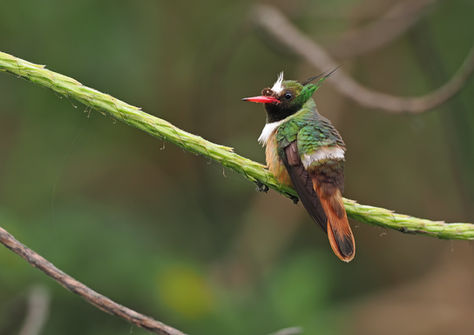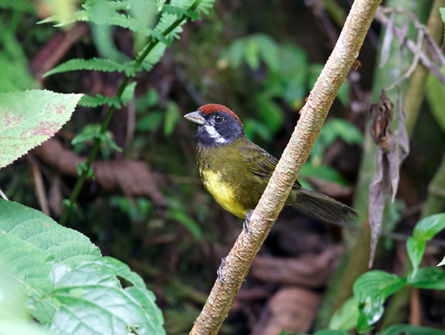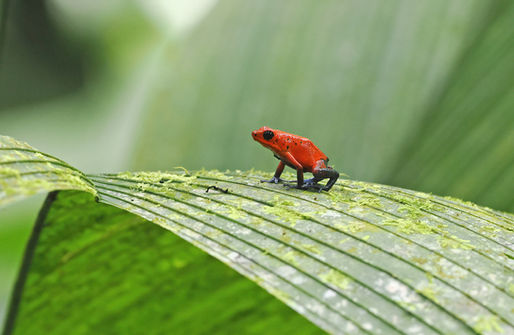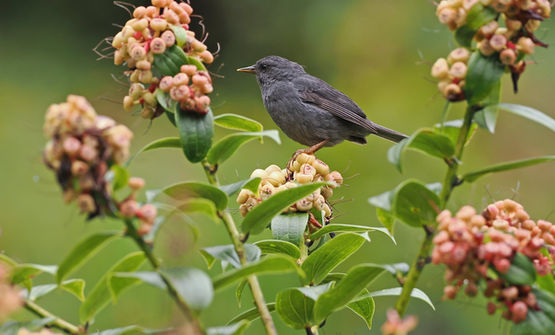Comprehensive Costa Rica: Birding from Border to Border
We are currently only offering this itinerary as a custom tour. Please contact us for details.
Tour Overview:
Costa Rica boasts an impressive bird list of just over 900 species, packed into a small country the size of West Virginia or Denmark. Within this list are some country endemics and highland specialties that are shared with only the far reaches of Panama. This is the longest tour we offer in Costa Rica that still offers the key species of our shorter, more relaxed Costa Rica Introtour, like the must-see Resplendent Quetzal, Wrenthrush, and Long-tailed Silky-Flycatcher, but also seeks a long list of extra species not possible on that birding tour like, Jabiru, Black-bellied Hummingbird, White-crested Coquette, White-bellied Mountain-Gem, Lattice-tailed Trogon, Cabanis’s Ground-Sparrow, Sooty-faced Finch, Costa Rican Brushfinch, Black-cheeked Ant-Tanager, Blue-and-gold Tanager, Velvety Manakin, and Nicaraguan Grackle to name just a handful! It also offers better chances at species like Snowcap, Turquoise Cotinga and Ocellated Antbird. It is also timed for a good shot at Three-wattled Bellbird, which is difficult on tours timed during the boreal wintertime. This tour covers all of the major biogeographical regions of the country: Caribbean Lowlands and Foothills, the North and South Pacific Lowlands, and the Foothills on the Pacific side, along with both the Lower and Upper Mountains, the coast and the Central Valley. This tour seeks to get an impressive bird list and will get more species than any other Tropical Birding Costa Rica tour.
Although we will be covering more areas and distance compared with that tour, Costa Rica is still a small country, and the drives are not especially long, with drives exceeding three hours on just four days. This will all be done while staying in a series of excellent, comfortable, bird-friendly hotels and lodges. We will almost always be staying right within the bird habitat, with a few nights at a hotel close to San Jose airport being the only exception to this. The other natural history that makes the Costa Rica Introtour such a popular tour will also be experienced too, whether it be sloths, monkeys or poison dart frogs, we will be on the lookout for these too.
If you are keen to do just one trip to Costa Rica, leaving as little behind as possible, so that you do not need to return, this is the optimum tour for you.
Detailed Itinerary
Day 1: Arrival in San Jose.
This is an arrival day with no birding planned, so you are free to arrive when you wish. The tour officially kicks off with a 6:30pm (estimated) dinner for the entire group with the guide, so you should plan to arrive a few hours before that. The night will be spent at a hotel in Alajuela, close to San Jose International Airport.
Day 2: Alajuela to Rancho Naturalista.
We will head east from Alajuela to one of the most revered birding lodges in all of Costa Rica, Rancho Naturalista, a site that boasts a bird list of more than 520 species! In the afternoon, we will arrive at Rancho Naturalista and begin to explore the surrounds of the lodge. Rancho Naturalista is known as the “Home of the Snowcap”, for it is arguably the best place in the country to find this amazing hummingbird. We will check the flowers around the lodge for both Snowcap and other hummingbirds such as Black-crested Coquette and Green-breasted Mango. Three nights will be spent at Rancho, where the food and remarkable service is as highly rated as the birding!
Days 3-4: Rancho Naturalista and Surrounds.
On at least one morning we will concentrate right around the lodge, checking the moth sheet first thing for birds like Tawny-chested Flycatcher, and the trails for the elusive Thicket Antpitta, White-ruffed Manakin, or Dull-mantled Antbird. Nearby sites will be checked for Sunbittern too. At night we will check the surrounds of the lodge for Mottled Owl.
Day 5: Reserva El Copal to Cartago.
Heading west from Rancho we will visit the excellent Reserva El Copal. This site, set within the foothills of the Caribbean slope has an enticing list of birds, and is loaded with tanagers in particular. We will be hoping to find some of the mixed flocks that roam the reserve, and can hold species like Speckled, Black-and-yellow, Blue-and-gold and Emerald Tanagers, as well as other specialties like Rufous-browed Tyrannulet and Tawny-capped Euphonia. In the afternoon we will move up to Hotel Quelitales, in Costa Rica’s lower mountains, one of Costa Rica’s mega hotspots, for a one-night stay.
Day 6: Hotel Quelitales to The Talamanca Highlands.
Our day will open at Hotel Quelitales, one of the best hummingbird sites in the country. Over 70% (more than 30 species) of Costa Rica’s hummingbirds have been recorded there, including Black-bellied Hummingbird, White-throated and White-bellied Mountain-Gems, and Green-fronted Lancebill. Hummingbirds will not be the only birds on our agenda though, as we will be seeking other specialties, like Sooty-faced Finch, Cabanis’s Ground-Sparrow and Dark Pewee. It is also one of the best sites in the country for Scaled Antpitta, although we wil still require considerable luck for us all to see this expertly elusive species. Other possible highlights could include Red-headed Barbet, Middle American Leaftosser, Ochre-breasted Antpitta, Slaty-backed Nightingale-Thrush and White-naped Brushfinch. In the afternoon, we shall head up higher in the mountains, moving east into the Talamanca Range, for a two-night stay.
Day 7: The Talamanca Highlands.
The Talamanca Mountains stretch from eastern Costa Rica into the far western edge of Panama and share a suite of specialties confined to them. These include Talamanca and Fiery-throated Hummingbirds, Spangle-cheeked Tanager, Flame-throated Warbler, Golden-browed Chlorophonia, Long-tailed Silky-Flycatcher, and Wrenthrush. This will also be the part of the trip where we will focus on finding one of Central America and Costa Rica’s most spectacular birds, the Resplendent Quetzal. At night we will search for Dusky Nightjar and Bare-shanked Screech-Owl. Two nights will be spent at Paraiso Quetzal, an excellent location for their namesake bird.
Day 8: Cerro de la Muerte to Talari.
During our final morning in the upper highlands, we will reach the highest point of the tour (c.9845ft/3000m) at Cerro del la Muerte, where we will seek high elevation specialists like Volcano Junco and Volcano Hummingbird. After that, we will continue our journey east along the Central American Isthmus, moving into the foothills of the Pacific slope of the mountains, and Talari Mountain Lodge. We will time our arrival, so that we get time in the late afternoon to look for the stunning Turquoise Cotinga, which can often be found close to the lodge. A single night will be spent at Talari.
Day 9: Talari to Esquinas via Rincon.
We will have some further time in the middle elevations of the Pacific side of the mountains, searching for species like White-crested Coquette, Garden Emerald, Pearl Kite, and Orange-billed Nightingale-Thrush, before we head further south into the South Pacific Lowlands. We will bird some mangroves set beside the Pacific Ocean around Rincon, searching for the ivory-colored Yellow-billed Cotinga perched atop the mangroves, or any Mangrove Hummingbirds, another country endemic, visiting any flowers within them too. In the evening, we will check into Esquinas Rainforest Lodge for a two-night stay.
Day 10: Esquinas Rainforest Lodge.
Esquinas Rainforest Lodge is located in verdant lowland rainforest alongside Piedras Blancas National Park, near the base of the Osa Peninsula. It holds a dizzy array of birds for us. Arguably, its most high-profile bird is the Black-cheeked Ant-Tanager, another species that is only found in Costa Rica. Other birds that occur there include Great Curassow, Charming Hummingbird, Baird’s Trogon, Olivaceous Piculet, Golden-naped Woodpecker, Black-hooded Antshrike, Orange-collared Manakin, Tropical Royal Flycatcher, Riverside and Black-bellied Wrens, and Red-breasted Meadowlark. At night we can also search for Spectacled Owl.
Day 11: Esquinas Rainforest Lodge to Las Cruces.
After birding around Esquinas again in the morning, we will continue south to Las Cruces Biological Station, where we will overnight. There should be some time to start birding that area in the afternoon.
Day 12: Wilson Botanical Gardens to Carara.
Our morning in the Wilson Botanical Gardens, within Las Cruces Biological Station, will have a substantial target list, to say the least! A scarce and local regional endemic, Costa Rican Brushfinch will be near the top of our wishlist, but this long list also includes White-tailed Emerald, Snowy-bellied Hummingbird, Fiery-billed Aracari, Blue-headed Parrot, Chiriqui Foliage-gleaner, Velvety Manakin, Rufous Piha, Green Shrike-Vireo, Spot-crowned Euphonia, Crested Oropendola, Red-crowned Ant-Tanager, Scarlet-thighed Dacnis, and Streaked Saltator! Our main focus on this day will be at these gardens, although we will move to a lodge near Carara NP by late afternoon keeping an eye out for Turquoise-browed Motmot, when we get close to there. A single night will be spent just outside the national park.
Day 13: Carara to Monteverde.
For today, we will spend the morning again in the Pacific Lowlands around Carara National Park, although by the afternoon we will have moved into the mountains again, although significantly lower than the previously visited mountains in the Talamancas. As we move into dry parts of the lower mountains, on the way to Monteverde, we will keep our eyes peeled for White-throated Magpie-Jays or White-fronted Parrots. We will stay in a small, family-run lodge close to the Monteverde Cloud Forest Reserve for the next two nights.
Day 14: Curi-Cancha and Monteverde.
We will begin our day by exploring a small, private reserve close to our lodge, Curi-Cancha. This is another good place to find Resplendent Quetzal, (should we still be seeking that flagship species) and is also home to the endemic Coppery-headed Emerald, Magenta-throated Woodstar, Northern Emerald Toucanet, Gray-throated Leaftosser, Elegant Euphonia, Golden-browed Chlorophonia, and White-eared Ground-Sparrow. We will plan to visit the World famous Monteverde Cloud Forest Reserve in the afternoon, after the morning crowds have subsided. We will check out the reserve’s hummingbird feeders for species like Violet Sabrewing and Purple-throated Mountain-Gem and walk some easy trails for other birds like Prong-billed Barbet, Azure-hooded Jay, Black-faced Solitaire, Slate-throated Redstart and Costa Rican Warbler. A second night will be spent in nearby Santa Elena town, the classic base from which to explore this hugely famous birding area.
Day 15: Monteverde to Bijagua.
Monteverde is located on the continental divide and holds a stark variety of habitats right around town, and an enviable number of birding sites to choose from. On the previous day we will have largely focused on cloud forest sites. However, on this day, we will explore some drier forests that are home to the stunning Long-tailed Manakin and incredible Three-wattled Bellbird. The latter is a migratory species that moves into the Monteverde area at this time of year to breed, when their explosive calls provide one of the characteristic backdrops to birding there. In the afternoon, we will drive north, crossing onto the northern, Caribbean, side of the mountains, where we will spend the next two nights at one of several lodges near Bijagua.
Day 16: Volcan Tenorio National Park and surroundings.
A full day will be spent on the slopes of Volcan Tenorio, within the Caribbean foothills. The area is home to a staggering 6 species of trogon, and a ridiculous 5 species of motmot, including both Tody and Keel-billed Motmots! Other scarcities on offer include Black-eared Wood-Quail, White-fronted Nunbird, Lovely Cotinga, and Rufous-winged Tanager. Other, more abundant, birds in the area include White-collared Manakin, Black-cowled Oriole and Blue-throated Goldentail. We will keep our eyes and ears out for raptors too, as Semiplumbeous Hawk and Ornate Hawk-Eagle are both found in the area too. This area is also good for antswarms, and we will be hoping to encounter army ants as they may lead us to birds like Spotted and Ocellated Antbirds.
Day 17: Bijagua to Cano Negro.
Much of the day be spent exploring the forested slopes of Volcan Tenorio, before we move north down into the Caribbean lowlands, and stay in Cano Negro. At night, we can search for Pacific Screech-Owl in the local area.
Day 18: Cano Negro to Braulio Carrillo.
For this morning, we will turn our attentions to wetland birds in the Cano Negro area. There are some real specialties to look for in this area, like Nicaraguan Grackle and Nicaraguan Seed-finch, belying its proximity to the Nicaraguan border, as well as Black-collared Hawk. Other birds of interest in this area include the mighty Jabiru, wild Muscovy Duck, Bare-throated Tiger-Heron, Boat-billed Heron, Green Ibis, and Russet-naped Wood-Rail. The morning will be spent around the wetlands, and then in the afternoon, we will drive southeast, back into the foothills of the Caribbean slope, where will stay two nights in a lodge just outside Braulio Carrillo National Park.
Day 19: Braulio Carrillo.
This area is one of the best spots in the entire country for the bizarre Bare-necked Umbrellabird, and we will follow up any recent sightings with vigor. However, we will still need significant luck to track down this notoriously elusive and unpredictable species. The area holds a series of other interesting scarcities, like Lattice-tailed Trogon, Yellow-eared Toucanet, Streak-chested Antpitta, Nightingale Wren, and White-throated Shrike-Tanager. Rufous-winged and Cinnamon Woodpeckers, Red-capped Manakin, Carmiol’s Tanager, and Black-faced Grosbeak are all also found there. A second night will be spent just outside Braulio Carrillo National Park.
Day 20: Braulio to San Jose.
After some final time in the foothills, chasing whatever we still need, we will return to our hotel near San Jose International Airport at the end of a comprehensive tour of Costa Rica, where we will not have left much behind and covered one end of the country to the other, in doing so adding a series of species not possible on Tropical Birding’s other Costa Rica tours.
Day 21: Departure from San Jose.
There is no birding scheduled for this day, and so you are free to leave when you wish, from San Jose’s International Airport.
Trip Considerations
PACE: Moderate to intense. This tour with try to see as many birds as possible, with special focus on the regional and country endemics. Many days will be quite full, and there are more one-night stays than on all of our other Costa Rica tours (i.e. 6). Lodges in Costa Rica don’t usually offer early breakfasts, and depending on breakfast times, there may be an optional pre-breakfast walk at 6:00am, with breakfast usually starting at around 6:30am or 7:00am; after breakfast the main morning birding will begin. There will be several nightbirding outings, but most are optional if you prefer to relax in the lodge instead. This tour covers a lot of ground, and there will be drives of 3 hours or more on at least four days of the trip.
PHYSICAL DIFFICULTY: Mostly easy to moderate, but with a few more difficult walks. Most of the birding will be on flat or slightly inclined roads or wide tracks. You can expect to walk around 2-3 miles (3.2-4.8 km) per day on average. On around five days of the trip there may be some more difficult trails with some steep and occasionally slippery sections (a walking stick can help). A few hours of one morning will be spent at high elevation (9845ft/3000 m), however all accommodation is located at 7200 ft (2200 m) or lower.
CLIMATE: Quite variable; in the lowlands, it is quite humid and temperatures usually vary from about 68°-95°F (20°-35°C). At the higher elevations it is much cooler, with temperatures ranging from about 46°-75°F (8°-24°C). Some rain can be expected. While the tour is generally timed best in the “dry season”, this dry season really applies only to the Pacific side of the mountains, and the sites on the Caribbean slope are typically wet year-round.
ACCOMMODATION: Very good to excellent, with private, en-suite bathrooms, full-time hot water, 24h electricity, and Wifi everywhere (often the latter is only available in common areas).
PHOTOGRAPHY: While this is a focused, intense, birding tour, there will be some good photo opps. along the way for the casual photographer and cameras are certainly welcome. There are often good chances to get photos of hummingbirds at feeders in Rancho, Paraiso Quetzal, Hotel Quelitales, and in Monteverde. Unplanned, shots of birds while birding in Costa Rica are often possible too, so you should not feel the need to leave a camera behind, even on this list focused tour.
Other Information
TRAVEL REQUIREMENTS: A valid passport is required; the passport must be valid for at least six months past your intended stay. Tourist visas are currently not required for citizens of the US, Canada, UK, Australia, New Zealand, South Africa, and EU countries. Visas are currently only required of nationalities mainly in Asia, Africa, Eastern Europe, and the Middle East. Travel requirements are subject to change; if you are unsure, please check with the nearest embassy or consulate, or ask our office staff for help.
WHAT’S INCLUDED?: Tips to drivers, local guides, and lodge/restaurant staff; accommodation from the night of day 1 to the night day 20; meals from dinner on day 1 (unless you arrive too late for dinner service) to breakfast on day 21 (if you have a very early departing flight, you may miss the included breakfast on the last day); safe drinking water and/or juice during meals (if eating at a restaurant that includes no drinks, reasonable non-alcoholic beverages will be provided for that meal); Tropical Birding tour leader with scope and audio gear from the evening of day 1 to the evening of day 20; one arrival and one departure airport transfer per person (transfers may be shared with other participants of the same tour if they are on the same flight; if the San José hotel has a free airport shuttle, you will be expected to use it and private transfers will not be provided); Ground transport for the group to all sites in the itinerary from days 2 to day 20 (for smaller groups the guide will drive, and for larger groups there will be a local driver); entrance fees to birding sites mentioned in the itinerary; a printed and bound checklist to keep track of your sightings (given to you at the start of the tour – only electronic copies can be provided in advance).
WHAT’S NOT INCLUDED?: Optional tips to the tour leader; tips for luggage porters if you require their services; flights; airport departure tax; snacks; additional drinks apart from those included; alcoholic beverages; travel insurance; excursions not included in the tour itinerary; extras in hotels such as laundry service, minibar, room service, telephone calls, and personal items; medical fees; other items or services not specifically mentioned as being included.
Tour Reviews
*Participated on this Tour? Leave a Review! We would also love to see your favorite photo, upload it!


























